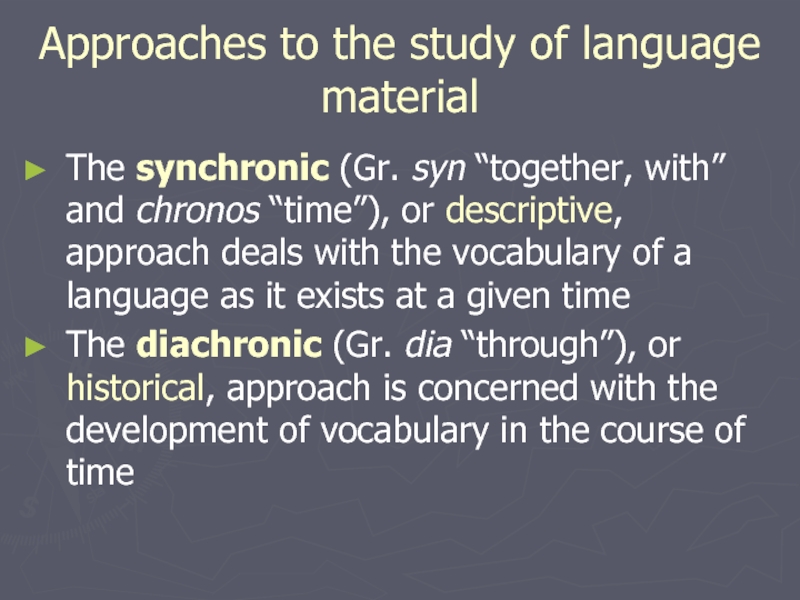LECTURE 1
1.1.Lexicology as a branch of linguistics. Its interrelations with other sciences
1.2.The word as the fundamental object of lexicology. The morphological structure of the English word
1.3.Inner structure of the word composition. Word building. The morpheme and its types. Affixation
1.1.Lexicology as a branch of linguistics. Its interrelations with other sciences. Lexicology (from Gr lexis “word” and logos “learning”) is a part of linguistics dealing with the vocabulary of a language and the properties of words as the main units of the language. It also studies all kinds of semantic grouping and semantic relations: synonymy, antonymy, hyponymy, semantic fields, etc.
In this connection, the term vocabulary is used to denote a system formed by the sum total of all the words and word equivalents that the language possesses. The term word denotes the basic unit of a given language resulting from the association of a particular meaning with a particular group of sounds capable of a particular grammatical employment. A word therefore is at the same time a semantic, grammatical and phonological unit. So, the subject-matter of lexicology is the word, its morphemic structure, history and meaning.
There are several branches of lexicology. The general study of words and vocabulary, irrespective of the specific features of any particular language, is known as general lexicology. Linguistic phenomena and properties common to all languages are referred to as language universals. Special lexicology focuses on the description of the peculiarities in the vocabulary of a given language. A branch of study called contrastive lexicology provides a theoretical foundation on which the vocabularies of different languages can be compared and described, the correlation between the vocabularies of two or more languages being the scientific priority.
Vocabulary studies include such aspects of research as etymology, semasiology and onomasiology.
The evolution of a vocabulary forms the object of historical lexicology or etymology (from Gr. etymon “true, real”), discussing the origin of various words, their change and development, examining the linguistic and extra-linguistic forces that modify their structure, meaning and usage.
Semasiology (from Gr. semasia “signification”) is a branch of linguistics whose subject-matter is the study of word meaning and the classification of changes in the signification of words or forms, viewed as normal and vital factors of any linguistic development. It is the most relevant to polysemy and homonymy.
Onomasiology is the study of the principles and regularities of the signification of things / notions by lexical and lexico-phraseological means of a given language. It has its special value in studying dialects, bearing an obvious relevance to synonymity.
Descriptive lexicology deals with the vocabulary of a language at a given stage of its evolution. It studies the functions of words and their specific structure as a characteristic inherent in the system. In the English language the above science is oriented towards the English word and its morphological and semantic structures, researching the interdependence between these two aspects. These structures are identified and distinguished by contrasting the nature and arrangement of their elements.
Within the framework of lexicology, both synchronic (Gr syn “together”, “with” and chronos “time”) and diachronic or historical (Gr dia “through”) approaches to the language suggested by the Swiss philologist Ferdinand de Saussure (1857-1913) are effectively realized. Language is the reality of thought, and thought develops together with the development of a society, thus the language and its vocabulary should be studied in the light of social history. Every new phenomenon in a human society in general, which is of any importance for communication, finds a reflection in the corresponding vocabulary. A word is considered to be a generalized reflection of reality; therefore, it is impossible to understand its development if one is ignorant of the changes in socio-political or everyday life, manners and culture, science of a linguoculture it serves to reflect. These extra-linguistic forces influencing the evolution of words are taken into the priority consideration in modern lexicology.
With regard to special lexicology the synchronic approach is concerned with the vocabulary of a language as it exists at a certain time (e.g., a course in Modern English Lexicology). The diachronic approach in terms of special lexicology deals with the changes and the development of the vocabulary in the course of time. It is special historical lexicology that deals with the evolution of vocabulary units as time goes by.
The two approaches should not be contrasted, as they are interdependent since every linguistic structure and system actually exists in a state of constant development so that the synchronic state of a language system is a result of a long process of linguistic evolution.
As every word is a unity of semantic, phonetic and grammatical elements, the word is studied not only in lexicology, but in other branches of linguistics, too, lexicology being closely connected with general linguistics, the history of the language, phonetics, stylistics, and grammar.
According to S. Ullmann, lexicology forms next to phonology, the second basic division of linguistic science (the third is syntax). Consequently, the interaction between vocabulary and grammar is evident in morphology and syntax. Grammar reflects the specific lexical meaning and the capacity of words to be combined in human actual speech. The lexical meaning of the word, in its turn, is frequently signaled by the grammatical context in which it occurs. Thus, morphological indicators help to differentiate the variant meanings of the word (e.g., plural forms that serve to create special lexical meaning: colors, customs, etc.; two kinds of pluralization: brother → brethren — brothers; cloth → cloths — clothes). There are numerous instances when the syntactic position of the word changes both its
function and lexical meaning (e.g., an adjective and a noun element of the same group can change places: library school — school library).
The interrelation between lexicology and phonetics becomes obvious if we think of the fact that the word as the basis unit in lexicological study cannot exist without its sound form, which is the object of study in phonology. Words consist of phonemes that are devoid of meaning of their own, but forming morphemes they serve to distinguish between meanings. The meaning of the word is determined by several phonological features: a) qualitative and quantitative character of phonemes (e.g. dog-dock, pot-port); b) fixed sequence of phonemes (e.g. pot-top, nest-sent-tens); 3) the position of stress (e.g. insult (verb) and insult (noun)).
Summarizing, lexicology is the branch of linguistics concerned with the study of words as individual items and dealing with both formal and semantic aspects of words; and although it is concerned predominantly with an in-depth description of lexemes, it gives a close attention to a vocabulary in its totality, the social communicative essence of a language as a synergetic system being a study focus.
1.2. The word as the fundamental object of lexicology. The morphological structure of the English word. A word is a fundamental unit of a language. The real nature of a word and the term itself has always been one of the most ambiguous issues in almost every branch of linguistics. To use it as a term in the description of language, we must be sure what we mean by it. To illustrate the point here, let us count the words in the following sentence: You can’t tie a bow with the rope in the bow of a boat. Probably the most straightforward answer to this is to say that there are 14. However, the orthographic perspective taken by itself, of course, ignores the meaning of the words, and as soon as we invoke meanings we at least are talking about different words bow, to start with.
Being a central element of any language system, the word is a focus for the problems of phonology, lexicology, syntax, morphology, stylistics and also for a number of other language and speech sciences.
Within the framework of linguistics the word has acquired definitions from the syntactic, semantic, phonological points of view as well as a definition combining various approaches. Thus, it has been syntactically defined as “the minimum sentence” by H.Sweet and much later as “the minimum independent unit of utterance” by L.Bloomfield.
E. Sapir concentrates on the syntactic and semantic aspects calling the word
“one of the smallest completely satisfying bits of isolated meaning, into which the sentence resolves itself”.
A purely semantic treatment is observed in S. Ullmann’s explanation of words as meaningful segments that are ultimately composed of meaningful units.
The prominent French linguist A. Meillet combines the semantic, phonological and grammatical criteria: “A word is defined by the association of a given meaning with a given group of sounds susceptible of a given grammatical employment”.
Our native school of linguistics understands the word as a dialectical doublefacet unit of form and content, reflecting human notions, and in this sense being considered as a form of their existence. Notions fixed in word meanings are formed as generalized and approximately correct reflections of reality, thus, signifying them words objectivize reality and conceptual worlds in their content.
So, the word is a basic unit of a language resulting from the association of a given meaning with a given cluster of sounds susceptible of a certain grammatical employment.
Taking into consideration the above, let us consider the nature of the word. First, the word is a unit of speech which serves the purposes of human communication. Thus, the word can be defined as a unit of communication.
Secondly, the word can be perceived as the total of the sounds which comprise it.
Third, the word, viewed structurally, possesses several characteristics.
a)The modern approach to the word as a double-facet unit is based on distinguishing between the external and the internal structures of the word. By the external structure of the word we mean its morphological structure. For example, in the word post-impressionists the following morphemes can be distinguished: the prefixes post-, im-, the root –press-, the noun-forming suffixes -ion, -ist, and the grammatical suffix of plurality -s. All these morphemes constitute the external structure of the word post-impressionists.
The internal structure of the word, or its meaning, is nowadays commonly referred to as the word’s semantic structure. This is the word’s main aspect. Words can serve the purposes of human communication solely due to their meanings.
b)Another structural aspect of the word is its unity. The word possesses both its external (or formal) unity and semantic unity. The formal unity of the word is sometimes inaccurately interpreted as indivisibility. The example of postimpressionists has already shown that the word is not, strictly speaking, indivisible, though permanently linked. The formal unity of the word can best be illustrated by comparing a word and a word-group comprising identical constituents. The difference between a blackbird and a black bird is best explained by their relationship with the grammatical system of the language. The word blackbird, which is characterized by unity, possesses a single grammatical framing: blackbirds. The first constituent black is not subject to any grammatical changes. In the word-group a black bird each constituent can acquire grammatical forms of its own: the blackest birds I’ve ever seen. Other words can be inserted between the components which is impossible so far as the word is concerned as it would violate its unity: a black night bird.
The same example may be used to illustrate what we mean by semantic unity. In the word-group a black bird each of the meaningful words conveys a separate concept: bird – a kind of living creature; black – a color. The word blackbird conveys only one concept: the type of bird. This is one of the main features of any
word: it always conveys one concept, no matter how many component morphemes it may have in its external structure.
c) A further structural feature of the word is its susceptibility to grammatical employment. In speech most words can be used in different grammatical forms in which their interrelations are realized.
So, the formal/structural properties of the word are 1) isolatability (words can function in isolation, can make a sentence of their own under certain circumstances); 2) inseparability/unity (words are characterized by some integrity, e.g. a light – alight (with admiration); 3) a certain freedom of distribution (exposition in the sentence can be different); 4) susceptibility to grammatical employment; 5) a word as one of the fundamental units of the language is a double facet unit of form (its external structure) and meaning (its internal/semantic structure).
To sum it up, a word is the smallest naming unit of a language with a more or less free distribution used for the purposes of human communication, materially representing a group of sounds, possessing a meaning, susceptible to grammatical employment and characterized by formal and semantic unity.
There are 4 basic kinds of words: 1)orthographic words – words distinguished from each other by their spelling; 2) phonological words – distinguished from each other by their pronunciation; 3) word-forms which are grammatical variants; 4) words as items of meaning, the headwords of dictionary entries, called lexemes. A lexeme is a group of words united by the common lexical meaning, but having different grammatical forms. The base forms of such words, represented either by one orthographic word or a sequence of words called multi-word lexemes which have to be considered as single lexemes (e.g. phrasal verbs, some compounds) may be termed citation forms of lexemes (sing, talk, head etc), from which other word forms are considered to be derived.
Any language is a system of systems consisting of two subsystems: 1) the system of words’ possible lexical meanings; 2) the system of words’ grammatical forms. The former is called the semantic structure of the word; the latter is its paradigm latent to every part of speech (e.g. a noun has a 4 member paradigm, an adjective – a 3 member one, etc)
As for the main lexicological problems, two of these have already been highlighted. The problem of word-building is associated with prevailing morphological word-structures and with the processes of coining new words. Semantics is the study of meaning. Modern approaches to this problem are characterized by two different levels of study: syntagmatic and paradigmatic.
On the syntagmatic level, the semantic structure of the word is analyzed in its linear relationships with neighboring words in connected speech. In other words, the semantic characteristics of the word are observed, described and studied on the basis of its typical contexts.
On the paradigmatic level, the word is studied in its relationships with other words in the vocabulary system. So, a word may be studied in comparison with other words of a similar meaning (e. g. work, n. – labor, n.; to refuse, v. – to reject v. – to decline, v.), of opposite meaning (e. g. busy, adj. – idle, adj.; to accept, v. –
to reject, v.), of different stylistic characteristics (e. g. man, n. – chap, n. – bloke, n.
— guy, n.). Consequently, the key problems of paradigmatic studies are synonymy, antonymy, and functional styles.
One further important objective of lexicological studies is the study of the vocabulary of a language as a system. Revising the issue, the vocabulary can be studied synchronically (at a given stage of its development), or diachronically (in the context of the processes through which it grew, developed and acquired its modern form). The opposition of the two approaches is nevertheless disputable as the vocabulary, as well as the word which is its fundamental unit, is not only what it is at this particular stage of the language development, but what it was centuries ago and has been throughout its history.
1.3. Inner structure of the word composition. Word building. The morpheme and its types. Morphemic analysis of words. Affixation. The word consists of morphemes. The term morpheme is derived from Greek morphe (form) + -eme. The Greek suffix -eme has been adopted by linguists to denote the smallest significant or distinctive unit. The morpheme may be defined as the smallest meaningful unit which has a sound form and meaning, occurring in speech only as a part of a word. In other words, a morpheme is an association of a given meaning with a given sound pattern. But unlike a word it is not autonomous. Morphemes occur in speech only as constituent parts of words, not independently, although a word may consist of a single morpheme. Nor are they divisible into smaller meaningful units. That is why the morpheme may also be defined as the minimum double-facet (shape/meaning) meaningful language unit that can be subdivided into phonemes (the smallest single-facet distinctive units of language with no meaning of their own). So there are 3 lower levels of a language – a phoneme, a morpheme, a word.
Word building (word-formation) is the creation of new words from elements already existing in a particular language. Every language has its own patterns of word formation. Together with borrowing, word-building provides for enlarging and enriching the vocabulary of the language.
A form is considered to be free if it may stand alone without changing its meaning; if not, it is a bound form, so called because it is always bound to something else. For example, comparing the words sportive and elegant and their parts, we see that sport, sortive, elegant may occur alone as utterances, whereas eleg-, -ive, -ant are bound forms because they never occur alone. A word is, by L. Bloomfield’s definition, a minimum free form. A morpheme is said to be either bound or free. This statement should be taken with caution because some morphemes are capable of forming words without adding other morphemes, being homonymous to free forms.
Words are segmented into morphemes with the help of the method of morphemic analysis whose aim is to split the word into its constituent morphemes and to determine their number and types. This is most effectively accomplished by the procedure known as the analysis into immediate constituents (IC’s), first suggested by L. Bloomfield. The procedure consists of
several stages: 1) segmentation of words; 2) identification of morphs; 3) classification of morphemes.
The procedure generally used to segment words into the constituting morphemes is the method of Immediate and Ultimate Constituents. It is based on a binary principle, i.e. each stage of the procedure involves two components the word immediately breaks into. At each stage these two components are referred to as the Immediate Constituents (ICs) Each IC at the next stage of the analysis is in turn broken into two smaller meaningful elements. This analysis is completed when we arrive at constituents incapable of any further division, i.e. morphemes. In terms of the method employed these are referred to as the Ultimate Constituents (UCs).
The analysis of the morphemic structure of words reveals the ultimate meaningful constituents (UCs), their typical sequence and arrangement, but it does not show the way a word is constructed. The nature, type and arrangement of the ICs of the word are known as its derivative structure. Though the derivative structure of the word is closely connected with its morphemic structure and often coincides with it, it cardinally differs from it. The derivational level of the analysis aims at establishing correlations between different types of words, the structural and semantic patterns being focused on, enabling one to understand how new words appear in a language.
Coming back to the issue of word segmentability as the first stage of the analysis into immediate constituents, all English words fall into two large classes: 1) segmentable words, i.e. those allowing of segmentation into morphemes, e.g. information, unputdownable, silently and 2) non-segmentable words, i.e. those not allowing of such segmentation, e.g. boy, wife, call, etc.
There are three types of segmentation of words: complete, conditional and defective. Complete segmentability is characteristic of words whose the morphemic structure is transparent enough as their individual morphemes clearly stand out within the word lending themselves easily to isolation. Its constituent morphemes recur with the same meaning in many other words, e.g. establishment, agreement.
Conditional morphemic segmentability characterizes words whose segmentation into constituent morphemes is doubtful for semantic reasons. For instance, in words like retain, detain, or receive, deceive the sound-clusters [ri], [di], on the one hand, can be singled out quite easily due to their recurrence in a number of words, on the other hand, they sure have nothing in common with the phonetically identical morphemes re-. de- as found in words like rewrite, reorganize, decode, deurbanize; neither the sound-clusters [ri], [di] nor the soundclusters [-tein], [si:v] have any lexical or functional meaning of their own. Therefore, the morphemes making up words of conditional segmentability differ from morphemes making up words of complete segmentability in that the former do not reach the full status of morphemes for the semantic reason and that is why a special term is applied to them – pseudo-morphemes or quasi-morphemes.
Defective morphemic segmentability is the property of words whose unique morphemic components seldom or never recur in other words (e.g. in the words
cranberry, gooseberry, strawberry defective morphemic segmentability is obvious due to the fact that the morphemes cran-, goose-, straw- are unique morphemes).
Thus, on the level of morphemic analysis there are basically two types of elementary units: full morphemes and pseudo- (quasi-)morphemes, the former being genuine structural elements of the language system in the prime focus of linguistic attention. At the same time, a significant number of words of conditional and defective segmentability reveal a complex nature of the morphological system of the English language, representing various heterogeneous layers in its vocabulary.
The second stage of morphemic analysis is identification of morphs. The main criteria here are semantic and phonetic similarity. Morphs should have the same denotational meaning, but their phonemic shape can vary (e.g. please, pleasing, pleasure, pleasant or duke, ducal, duchess, duchy). Such phonetically conditioned positional morpheme variants are called allomorphs. They occur in a specific environment, being identical in meaning or function and characterized by complementary distribution.(e.g. the prefix in- (intransitive) can be represented by allomorphs il- (illiterate), im- (impossible), ir- (irregular)). Complementary distribution is said to take place when two linguistics variants cannot appear in the same environment (Not the same as contrastive distribution by which different morphemes are characterized, i.e. if they occur in the same environment, they signal different meanings (e.g. the suffixes -able (capable of being): measurable and -ed (a suffix of a resultant force): measured).
The final stage of the procedure of the morphemic analysis is classification of morphemes. Morphemes can be classified from 6 points of view (POV).
1. Semantic POV: roots and affixes/non-roots. A root is the lexical nucleus of a word bearing the major individual meaning common to a set of semantically related words, constituting one word cluster/word-family (e.g. learn-learner- learned-learnable; heart-hearten, dishearten, hear-broken, hearty, kind-hearted etc.) with which no grammatical properties of the word are connected. In this respect, the peculiarity of English as a unique language is explained by its analytical language structure – morphemes are often homonymous with independent units (words). A morpheme that is homonymous with a word is called a root morpheme.
Here we have to mention the difference between a root and a stem. A root is the ultimate constituent which remains after the removal of all functional and derivational affixes and does not admit any further analysis. Unlike a root, a stem is that part of the word that remains unchanged throughout its paradigm (formal aspect). For instance, heart-hearts-to one’s heart’s content vs. hearty-heartier-the heartiest. It is the basic unit at the derivational level, taking the inflections which shape the word grammatically as a part of speech.
There are three types of stems: simple, derived and compound.
Simple stems are semantically non-motivated and do not constitute a pattern on analogy with which new stems may be modeled (e.g. pocket, motion, receive, etc.).
Simple stems are generally monomorphic and phonetically identical with the root morphemes (sell, grow, kink, etc.).
Derived stems are built on stems of various structures, they are motivated, i.e. derived stems are understood on the basis of the derivative relations between their immediate constituents and the correlated stems. Derived stems are mostly polymorphic (e.g. governments, unbelievable, etc.).
Compound stems are made up of two immediate constituents, both of which are themselves stems, e.g. match-box, pen-holder, ex-film-star, etc. It is built by joining two stems, one of which is simple, the other is derived.
The derivational types of words are classified according to the structure of their stems into simple, derived and compound words.
Derived words are those composed of one root-morpheme and one or more derivational morphemes.
Compound words have at least two root-morphemes, the number of derivational morphemes being insignificant.
So, there are 4 structural types of words in English: 1) simple words (singleroot morphemes, e.g. agree, child, red, etc.); 2) derivatives (affixational derived words) consisting one or more affixes: enjoyable, childhood, unbelievable). Derived words are extremely numerous in the English vocabulary. Successfully competing with this structural type is the so-called root word which has only a root morpheme in its structure. This type is widely represented by a great number of words belonging to the original English stock or to earlier borrowings (house, room, book, work, port, street, table, etc.). In Modern English, it has been greatly enlarged by the type of word-building called conversion (e. g. to hand, v. formed from the noun hand; to can, v. from can, n.; to pale, v. from pale, adj.; a find, n. from to find, v.; etc.); 3) compound words consisting of two or more stems (e. g. dining-room, bluebell, mother-in-law, good-for-nothing, etc.). Words of this structural type are produced by the word-building process called composition; 4) derivational compounds in which phrase components are joined together by means of compounding and affixation (e.g. oval-shaped, strong-willed, care-free); 5) phrasal verbs as a result of a strong tendency of English to simplification (to put up with, to give up, to take for, etc.)
The morpheme, and therefore the affix, which is a type of morpheme, is generally defined as the smallest indivisible component of the word possessing a meaning of its own. Meanings of affixes are specific and considerably differ from those of root morphemes. Affixes have widely generalized meanings and refer the concept conveyed by the whole word to a certain category, which is all-embracing. So, the noun-forming suffix -er could be roughly defined as designating persons from the object of their occupation or labor (painter – the one who paints) or from their place of origin (southerner – the one living in the South). The adjectiveforming suffix -ful has the meaning of «full of», «characterized by» (beautiful, careful) whereas -ish may often imply insufficiency of quality (greenish – green, but not quite).
There are numerous derived words whose meanings can really be easily deduced from the meanings of their constituent parts. Yet, such cases represent only the first stage of semantic readjustment within derivatives. The constituent morphemes within derivatives do not always preserve their current meanings and are open to subtle and complicated semantic shifts (e.g. bookish: (1) given or devoted to reading or study; (2) more acquainted with books than with real life, i. e. possessing the quality of bookish learning).
The semantic distinctions of words produced from the same root by means of different affixes are also of considerable interest, both for language studies and research work. Compare: womanly (used in a complimentary manner about girls and women) – womanish (used to indicate an effeminate man and certainly implies criticism); starry (resembling stars) – starred (covered or decorated with stars).
There are a few roots in English which have developed a great combining ability in the position of the second element of a word and a very general meaning similar to that of an affix. These are semi-affixes because semantically, functionally, structurally and stylistically they behave more like affixes than like roots, determining the lexical and grammatical class the word belongs to (e.g. -man: cameraman, seaman; -land: Scotland, motherland; -like: ladylike, flowerlike; — worthy: trustworthy, praiseworthy; -proof: waterproof, bullet-proof, etc.)
2.Position POV: according to their position affixational morphemes fall into suffixes – derivational morphemes following the root and forming a new derivative in a different part of speech or a different word class (writer, rainy, magnify, etc.), infexes – affixes placed within the word (e.g. adapt-a-tion, assimil-a-tion, sta-n-d etc.), and prefixes – derivational morphemes that precede the root and modify the meaning (e.g. decipher, illegal, unhappy, etc.) The process of affixation itself consists in coining a new word by adding an affix or several affixes to a root morpheme. Suffixation is more productive than prefixation in Modern English.
3.Functional POV: from this perspective affixational morphemes include derivational morphemes as affixal morphemes that serve to make a new part of speech or create another word in the same one, modifying the lexical meaning of the root (e.g. to teach-teacher; possible-impossible), and functional morphemes, i.e. grammatical ones/inflections that serve to build grammatical forms, the paradigm of the word (e.g. has broken; oxen; clues), carrying only grammatical meaning and thus relevant only for the formation of words. Some functional morphemes have a dual character. They are called functional word-morphemes (FWM) – auxiliaries (e.g. is, are, have, will, etc). The main function of FWM is to build analytical structures.
As for word combinations, being two components expressing one idea (e.g. to give up – to refuse; to take in – to deceive) they are full fleshed words. Their function is to derive new words with new meanings. They behave like derivational morphemes with a functional form. They are called derivational word
Соседние файлы в предмете [НЕСОРТИРОВАННОЕ]
- #
- #
- #
- #
- #
- #
- #
- #
- #
- #
- #
Lecture №1. The Object of Lexicology. Words of Native Origin and their Characteristic
Modern English Lexicology aims at giving a systematic description of the word-stock of Modern English. Words, their component parts – morphemes – and various types of word-groups, are subjected to structural and semantic analysis primarily from the synchronic angle. In other words, Modern English Lexicology investigates the problems of word-structure and word-formation in Modern English, the semantic structure of English words, the main principles underlying the classification of vocabulary units into various groupings the laws governing the replenishment of the vocabulary with new vocabulary units. It also studies the relations existing between various lexical layers of the English vocabulary and the specific laws and regulations that govern its development at the present time. The source and growth of the English vocabulary, the changes it has undergone in its history are also dwelt upon, as the diachronic approach revealing the vocabulary in the making cannot but contribute to the understanding of its workings at the present time.
LEXICOLOGY
The term «lexicology» is of Greek origin / from «lexis» – «word» and «logos» – «science»/. Lexicology is the part of linguistics which deals with the vocabulary and characteristic features of words and word-groups. The term «vocabulary» is used to denote the system of words and word-groups that the language possesses. The term «word» denotes the main lexical unit of a language resulting from the association of a group of sounds with a meaning. This unit is used in grammatical functions characteristic of it. It is the smallest unit of a language which can stand alone as a complete utterance. The term «word—group» denotes a group of words which exists in the language as a ready-made unit, has the unity of meaning, the unity of syntactical function, e.g. the word-group «as loose as a goose» means «clumsy» and is used in a sentence as a predicative / He is as loose as a goose/. Lexicology can study the development of the vocabulary, the origin of words and word-groups, their semantic relations and the development of their sound form and meaning. In this case it is called historical lexicology. Another branch of lexicology is called descriptive and studies the vocabulary at a definite stage of its development.
LANGUAGE UNITS
The main unit of the lexical system of a language resulting from the association of a group of sounds with a meaning is a word. This unit is used in grammatical functions characteristic of it. It is the smallest language unit which can stand alone as a complete utterance. A word, however, can be divided into smaller sense units – morphemes. The morpheme is the smallest meaningful language unit. The morpheme consists of a class of variants, allomorphs, which are either phonologically or morphologically conditioned, e.g. please, pleasant, pleasure.
Morphemes are divided into two large groups: lexical morphemes and grammatical (functional) morphemes. Both lexical and grammatical morphemes can be free and bound. Free lexical morphemes are roots of words which express the lexical meaning of the word, they coincide with the stem of simple words. Free grammatical morphemes are function words: articles, conjunctions and prepositions (the, with, and).
Bound lexical morphemes are affixes: prefixes (dis-), suffixes (-ish) and also blocked (unique) root morphemes (e.g. Fri-day, cran-berry). Bound grammatical morphemes are inflexions (endings), e.g. -s for the Plural of nouns, -ed for the Past Indefinite of regular verbs, -ing for the Present Participle, -er for the Comparative degree of adjectives.
In the second half of the twentieth century the English word-building system was enriched by creating so called splinters which scientists include in the affixation stock of the Modern English word-building system. Splinters are the result of clipping the end or the beginning of a word and producing a number of new words on the analogy with the primary word-group. For example, there are many words formed with the help of the splinter mini- (apocope produced by clipping the word «miniature»), such as «minijet», «minicycle», «minicar», «miniradio» and many others. All of these words denote objects of smaller than normal dimensions.
On the analogy with «mini-» there appeared the splinter «maxi» — (apocope produced by clipping the word «maximum»), such words as «maxi-series», «maxi-sculpture», «maxi-taxi» and many others appeared in the language.
When European economic community was organized quite a number of neologisms with the splinter Euro— (apocope produced by clipping the word «European») were coined, such as: «Euratom» «Eurocard», «Euromarket», «Eurotunnel» and many others. These splinters are treated sometimes a prefixes in Modern English. There are also splinters which are formed by means of apheresis, that is clipping the beginning of a word. The origin of such splinters can be variable, e.g. the splinter «burger» appeared in English as the result of clipping the German borrowing «Hamburger» where the morphological structure was the stem «Hamburg» and the suffix -er. However in English the beginning of the word «Hamburger» was associated with the English word «ham», and the end of the word «burger» got the meaning «a bun cut into two parts». On the analogy with the word «hamburger» quite a number of new words were coined, such as: «baconburger», «beefburger», «cheeseburger», «fishburger» etc.
The splinter «cade» developed by clipping the beginning of the word «cavalcade» which is of Latin origin. In Latin the verb with the meaning «to ride a horse» is «cabalicare» and by means of the inflexion —ata the corresponding Participle is formed. So the element «cade» is a combination of the final letter of the stem and the inflexion. The splinter «cade» serves to form nouns with the meaning «connected with the procession of vehicles denoted by the first component», e.g. «aircade» – «a group of airplanes accompanying the plane of a VIP», «autocade» – «a group of automobiles escorting the automobile of a VIP», «musicade» – «an orchestra participating in a procession».
In the seventieths of the twentieth century there was a political scandal in the hotel «Watergate» where the Democratic Party of the USA had its pre-election headquarters. Republicans managed to install bugs there and when they were discovered there was a scandal and the ruling American government had to resign. The name «Watergate» acquired the meaning «a political scandal», «corruption». On the analogy with this word quite a number of other words were formed by using the splinter «gate» (apheresis of the word «Watergate»), such as: «Irangate», «Westlandgate», «shuttlegate», «milliongate» etc. The splinter «gate» is added mainly to Proper names: names of people with whom the scandal is connected or a geographical name denoting the place where the scandal occurred.
The splinter «mobile» was formed by clipping the beginning of the word «automobile» and is used to denote special types of automobiles, such as: «artmobile», «bookmobile», «snowmobile» etc.
The splinter «napper» was formed by clipping the beginning of the word «kidnapper» and is used to denote different types of crimesters, such as: «busnapper», «babynapper», «dognapper» etc. From such nouns the corresponding verbs are formed by means of backformation, e.g. «to busnap», «to babynap», «to dognap».
The splinter «omat» was formed by clipping the beginning of the word «automat» (a cafe in which meals are provided in slot-machines). The meaning «self-service» is used in such words as «laundromat», «cashomat» etc.
Another splinter «eteria» with the meaning «self-service» was formed by clipping the beginning of the word «cafeteria». By means of the splinter «eteria» the following words were formed: «groceteria», «booketeria», «booteteria» and many others.
The splinter «quake» is used to form new words with the meaning of «shaking», «agitation». This splinter was formed by clipping the beginning of the word «earthquake». The following words were formed with the help of this splinter: «Marsquake», «Moonquake», «youthquake» etc.
The splinter «rama(ama)» is a clipping of the word «panorama» of Greek origin where «pan» means «all» and «horama» means «view». In Modern English the meaning «view» was lost and the splinter «rama» is used in advertisements to denote objects of supreme quality, e.g. «autorama» means «exhibition-sale of expensive cars», «trouserama» means «sale of trousers of supreme quality» etc.
The splinter «scape» is a clipping of the word «landscape» and it is used to form words denoting different types of landscapes, such as: «moonscape», «streetscape», «townscape», «seascape» etc.
Another case of splinters is «tel» which is the result of clipping the beginning of the word «hotel». It serves to form words denoting different types of hotels, such as: «motel» (motor-car hotel), «boatel» (boat hotel), «floatel» (a hotel on water, floating), «airtel» (airport hotel) etc.
The splinter «theque» is the result of clipping the beginning of the word «apotheque» of Greek origin which means in Greek «a store house». In Russian words: «библиотека», «картотека», «фильмотека» the element «тека» corresponding to the English «theque» preserves the meaning of storing something which is expressed by the first component of the word. In English the splinter «theque» is used to denote a place for dancing, such as: «discotheque», «jazzotheque».
The splinter «thon» is the result of clipping the beginning of the word «marathon». «Marathon» primarily was the name of a battle-field in Greece, forty miles from Athens, where there was a battle between the Greek and the Persian. When the Greek won a victory a Greek runner was sent to Athens to tell people about the victory. Later on the word «Marathon» was used to denote long-distance competitions in running. The splinter «thon(athon)» denotes «something continuing for a long time», «competition in endurance» e.g. «dancathon», «telethon», «speakathon», «readathon», «walkathon», «moviethon», «swimathon», «talkathon» etc.
Splinters can be the result of clipping adjectives or substantivized adjectives. The splinter «aholic» (holic) was formed by clipping the beginning of the word «alcoholic» of Arabian origin where «al» denoted «the», «koh’l» – «powder for staining lids». The splinter «(a)holic» means «infatuated by the object expressed by the stem of the word», e.g. «bookaholic», «computerholic», «coffeeholic», «cheesaholic», «workaholic» and many others.
The splinter «genic» formed by clipping the beginning of the word «photogenic» denotes the notion «suitable for something denoted by the stem», e.g. «allergenic», «cardiogenic», «mediagenic», «telegenic» etc.
As far as verbs are concerned it is not typical of them to be clipped that is why there is only one splinter to be used for forming new verbs in this way. It is the splinter «cast» formed by clipping the beginning of the verb «broadcast». This splinter was used to form the verbs «telecast» and «abroadcast».
Splinters can be called pseudomorphemes because they are neither roots nor affixes, they are more or less artificial. In English there are words which consist of two splinters, e.g. «telethon», therefore it is more logical to call words with splinters in their structure «compound-shortened words consisting of two clippings of words».
Splinters have only one function in English: they serve to change the lexical meaning of the same part of speech, whereas prefixes and suffixes can also change the part-of-speech meaning, e.g. the prefix «en-» and its allomorph «em» can form verbs from noun and adjective stems («embody», «enable», «endanger»), «be-» can form verbs from noun and adjective stems («becloud», «benumb»), «post-» and «pre-» can form adjectives from noun stems («pre-election campaign», «post-war events»). The main function of suffixes is to form one part of speech from another part of speech, e.g. «-er», «-ing», «-ment» form nouns from verbal stems («teacher», «dancing», «movement»), «-ness», «-ity» are used to form nouns from adjective stems («clannishness», «marginality»).
According to the nature and the number of morphemes constituting a word there are different structural types of words in English: simple, derived, compound, compound-derived. Simple words consist of one root morpheme and an inflexion (in many cases the inflexion is zero), e.g. «seldom», «chairs», «longer», «asked». Derived words consist of one root morpheme, one or several affixes and an inflexion, e.g. «derestricted», «unemployed». Compound words consist of two or more root morphemes and an inflexion, e.g. «baby-moons», «wait-and-see (policy)». Compound—derived words consist of two or more root morphemes, one or more affixes and an inflexion, e.g. «middle-of-the-roaders», «job-hopper».
When speaking about the structure of words stems also should be mentioned. The stem is the part of the word which remains unchanged throughout the paradigm of the word, e.g. the stem «hop» can be found in the words: «hop», «hops», «hopped», «hopping». The stem «hippie» can be found in the words: «hippie», «hippies», «hippie’s», «hippies’». The stem «job-hop» can be found in the words: «job-hop», «job-hops», «job-hopped», «job-hopping».
So stems, the same as words, can be simple, derived, compound and compound-derived. Stems have not only the lexical meaning but also grammatical (part-of-speech) meaning, they can be noun stems («girl» in the adjective «girlish»), adjective stems («girlish» in the noun «girlishness»), verb stems («expel» in the noun «expellee») etc. They differ from words by the absence of inflexions in their structure, they can be used only in the structure of words. Sometimes it is rather difficult to distinguish between simple and derived words, especially in the cases of phonetic borrowings from other languages and of native words with blocked (unique) root morphemes, e.g. «perestroika», «cranberry», «absence» etc. As far as words with splinters are concerned it is difficult to distinguish between derived words and compound-shortened words. If a splinter is treated as an affix (or a semi-affix) the word can be called derived, e.g. — «telescreen», «maxi-taxi», «cheeseburger». But if the splinter is treated as a lexical shortening of one of the stems, the word can be called compound-shortened word formed from a word combination where one of the components was shortened, e.g. «busnapper» was formed from «bus kidnapper», «minijet» from «miniature jet».
In the English language of the second half of the twentieth century there developed so called block compounds, that is compound words which have a uniting stress but a split spelling, such as «chat show», «penguin suit» etc. Such compound words can be easily mixed up with word-groups of the type «stone wall», so called nominative binomials. Such linguistic units serve to denote a notion which is more specific than the notion expressed by the second component and consists of two nouns, the first of which is an attribute to the second one. If we compare a nominative binomial with a compound noun with the structure N+N we shall see that a nominative binomial has no unity of stress. The change of the order of its components will change its lexical meaning, e.g. «vid kid» is «a kid who is a video fan» while «kid vid» means «a video-film for kids» or else «lamp oil» means «oil for lamps» and «oil lamp» means «a lamp which uses oil for burning». Among language units we can also point out word combinations of different structural types of idiomatic and non-idiomatic character, such as «the first fiddle», «old salt» and «round table», «high road». There are also sentences which are studied by grammarians.
Thus, we can draw the conclusion that in Modern English the following language units can be mentioned: morphemes, splinters, words, nominative binomials, non-idiomatic and idiomatic word-combinations, sentences.
WORDS OF NATIVE ORIGIN AND THEIR CHARACTERISTICS
Etymologically the vocabulary of the English language is far from being homogeneous. It consists of two layers – the native stock of words and the borrowed stock of words. Native words comprise only 30% of the total number of words in the English vocabulary but the native words form the bulk of the most frequent words actually used in speech and writing. The native element in English comprises a large number of high-frequency words like the articles, prepositions, pronouns, conjunctions, auxiliaries and, also, words denoting everyday objects and ideas (e. g. house, child, water, go, come, eat, good, bad, etc.). Words belonging to the subsets of the native word-stock are for the most part characterized by a wide range of lexical and grammatical valency, high frequency value and a developed polysemy; they are often monosyllabic, show great word-building power and enter a number of set expressions. Furthermore, the grammatical structure is essentially Germanic having remained unaffected by foreign influence.
A native word is a word which belongs to the original English stock, as known from the earliest available manuscripts of the Old English period. A loan word, borrowed word or borrowing is a word taken over from another language and modified in phonemic shape, spelling, paradigm or meaning according to the standards of the English language.
The native words are further subdivided by diachronic linguistics into those of the Indo-European stock and those of Common Germanic origin i.e. of words having parallels in German, Norwegian, Dutch, Icelandic, etc., but none in Russian, Ukrainian or French. The words having the cognates (words of the same etymological root, of common origin) in the vocabularies of different Indo-European languages form the oldest layer which readily falls into definite semantic groups: Family relations: father, mother, brother, son, daughter (cf. Ukr. мати, брат, син.). Parts of the human body: foot (cf. Rus. пядь), nose (cf. Ukr. ніс), lip, heart. Animals: cow, swine, goose. Plants: tree, birch (cf. Rus. береза), corn (cf. Rus. зерно). Time of day: day, night. Heavenly bodies: sun, moon, star. Numerous adjectives: red (cf. Ukr. рудий, Rus. рыжий), new, glad (cf. Rus. гладкий), sad (cf. Rus. сыт). The numerals from one to a hundred.
Pronouns: personal (except they which is a Scandinavian borrowing); demonstrative. Numerous verbs: be (cf. Rus. быть), stand (cf. Rus. стоять), sit (cf. Rus. сидеть), eat (cf. Rus. есть), know (cf. Rus. знать, знаю). Some of the most frequent verbs are also of Indo-European common stock: bear, come; sit, stand and others. The adjectives of this group denote concrete physical properties: hard, quick, slow, red, white. Most numerals also belong here.
The Germanic element represents words of roots common to all or most Germanic languages. Some of the main groups of Germanic words are the same as in the Indo-European element. Parts of the human body: head, hand, arm, finger, bone. Animals: bear, fox, calf. Plants: oak, fir, grass. Natural phenomena: rain, frost. Seasons of the year: winter, spring, summer. Landscape features: sea, land. Human dwellings and furniture: house, room, bench. Sea-going vessels: boat, ship. Adjectives: green, blue, grey, white, small, thick, high, old, good. Verbs: see, hear, speak, tell, say, answer, make, give, drink.
Many adverbs and pronouns also belong to this layer. It is probably of some interest to mention that at various times purists have tried to purge the English language of foreign words, replacing them with Anglo-Saxon ones. One slogan created by these linguistic nationalists was: “Avoid Latin derivatives; use brief, terse Anglo-Saxon monosyllables”. The irony is that the only Anglo-Saxon word in the entire slogan is “Anglo-Saxon”.
6
1. Lecture 1
Theoretical Foundations of
Lexicology
2. Is English a language of PARADOXES?
► One
in every 7 human
beings can speak it
► More than half of the
world’s books
► three-quarters of
international mail are
in English
► The largest vocabulary
► One of the noblest
bodies of literature
There’s no egg in
eggplant (баклажан)
There’s neither pine nor
apple in pineapple
(ананас)
Sweetmeats (конфеты)
are candy
Sweetbreads («сладкое
мясо», зобная и
поджелудочная железы,
употребляемые в пищу),
which are not sweet, are
meat, etc.
3. Plan
► I.
The aim and object of Lexicology. Its
branches, links with other linguistic
disciplines.
► II. Definition of the word. Motivation of
words. Functions of words.
► III. Vocabulary as a system. Paradigmatic
and syntagmatic relations. Diachronic and
synchronic approaches to the study of the
vocabulary.
4. I. The aim and object of Lexicology. Its branches, links with other linguistic disciplines.
5. The aim and object of Lexicology
(Gr. lexis “word” and logos
“learning”) is a branch of Linguistics which
studies the vocabulary of a language and
characteristic features of lexical units.
► Lexical units studied by Lexicology:
morphemes, words, word-groups and
phraseological units.
► Lexicology
6. Branches of Lexicology
► General
Lexicology is general study of
words and vocabulary, irrespective of
specific features of any particular language.
► Special Lexicology is Lexicology of a
particular language.
7. Branches of Lexicology studying different aspects of words (1)
► Etymology
studies origin of words and
historical changes in meanings: e.g. OE
harvest “осень” > MnE “урожай”
► Semasiology
deals with semantic structure
of words, development of meanings: e.g.
“hand” – about 40 LSV
► Word-building
studies the process of
creating new words, their structural and
semantic patterns: e.g. drive (V+ -er)
8. Branches of Lexicology studying different aspects of words (2)
► Phraseology
studies word-groups with
specialized meanings: e.g. butter-fingers
(растяпа)
► Borrowing
deals with the process of
adopting and assimilating words from other
languages: e.g. sky, skin – Sc.; government,
army – Fr.
9. Links of Lexicology with other linguistic disciplines
► Phonetics
► Grammar
► Stylistics
10. Connection with Phonetics
► on
the acoustic level words consist of
phonemes which distinguish between
meanings thus participating in signification:
e.g. `object (a noun) :: ob`ject (a verb),
cop :: cope (different words), `blackbird (a
compound noun) :: `black `bird (a wordgroup).
11. Connection with Grammar
The lexical meaning of a word can be conditioned
by its grammatical forms: e.g. glass (стекло), a
glass (стакан), glasses (очки);
• The lexical meaning of a word may affect its
grammatical forms and syntactical functions:
e.g.come true, turn red, go wrong;
• Grammatical meaning can be expressed by lexical
means: e.g. We are going there tomorrow instead
of We shall go there.
12. Connection with Stylistics
► Differentiation
of vocabulary according to
the functional styles of the language
conditions the connection of Lexicology with
Stylistics: e.g. the synonyms father and
dad differing in a shade of meaning belong
to different functional styles (dad is
informal, father is neutral or formal).
13. II. Definition of the word. Motivation of words. Functions of words.
14. The Word as the Principal Object of Lexicology
► The
word is the minimal (after the
morpheme) meaningful unit of the
language, a two-plane linguistic sign,
possessing both form (the plane of
expression) and meaning (the plane of
content).
15. Asymmetrical dualism of a linguistic sign
► Sound
form and meaning of a word are
firmly associated with each other in the
mind of a speaker but each of them has
relative independence: sound form tends to
develop polysemy and further homonymy
(e.g. dull – 1. lacking interest; 2. lacking
brightness; 3. slow to understand, etc.),
while meaning tends to develop synonymy
(e.g. boring; gloomy; stupid, etc.).
16. Motivation of words
(motivation is the relationship between
phonemic or morphemic composition of the
word and its meaning)
► phonetical (e.g. hiss, buzz, cuckoo)
► morphological (e.g. thinker, selfpropelling, endless)
► semantic (e.g. hand of a clock, mouth of a
river)
17. Phonetical motivation
► 1)
based on similarity between the sounds
which make up words and the sounds these
words denote: e.g. boom, splash, whistle
► 2) based on association between some
sound-clusters and a certain meaning
(phonetical symbolism): e.g. [fl] (“quick
movement”) – flap, flash, flutter; [sl]
(“mud”) – sleet, slush
► But: flat, floor, slim (non-motivated)
18. Morphological motivation
► based
on direct connection between the
morphological structure of the word and its
meaning: e.g. poetess, overestimate,
regain, blackberry
► But: repeat, matter, cranberry (nonmotivated)
19. Semantic motivation
► Based
on co-existence of direct and
figurative meaning: e.g. foot of a page, eye
of a needle, head of an army (metaphoric
transfer); astrakhan, china, tweed
(metonymic transfer)
20. Functions of words (1-3)
► significative
function which consists in
expressing a general idea (characteristic of
all signs);
► nominative function (typical of notional
words);
► representative function (peculiar to
proper names);
21. Functions of words (4-6)
► deictic
function (typical of demonstrative,
possessive, reflexive and relative pronouns and of
adverbs);
► expressive function which consists in rendering
emotions or attitude (peculiar to interjections oh,
wow, ouch, Why! etc. and other emotionally
coloured words, such as kid, dear, honey, puppy,
etc.);
► interpretative function (characteristic of
linguistic units with transferred meaning);
22. Functions of words (7-9)
► cumulative
function which consists in
enriching semantic structure of words;
► pragmatic function which consists in
acquiring connotations according to the
sphere of communication;
► structural function which consists in
serving as a basic structural material of a
language
23. Word and Lexeme
► The
invariant of a word in all its meanings
and forms is called lexeme.
The child wanted to play with other children
(8 words, 7 lexemes)
24. Word and Lexeme
► The
► The
word is a unit of speech.
lexeme is a unit of the lexical system of
the language.
25. Word and Lexeme
► The
system showing a word in all its wordforms is called a paradigm. The lexical
meaning of a word is the same through its
paradigm, while the grammatical meaning is
different: e.g. take – took – takes – taking.
26. III. Vocabulary as a system. Paradigmatic and syntagmatic relations. Diachronic and synchronic approaches to the study of the
vocabulary.
27. Vocabulary as a system
► Vocabulary
is a system, i.e. a coherent
homogeneous whole, constituted by
interdependent elements of the same order
related in certain specific ways.
28. Relations between linguistic units
► Paradigmatic
relations (in language)
are based on
interdependence of
words in the
vocabulary system:
e.g. to run, to jog, to
rush, to race
(synonymic group); to
accept – to reject
(antonyms).
► Syntagmatic
relations (in speech)
are linear relations
based on the influence
of context: e.g. illegal /
irregular, to tell smb. /
to say smth.
29. Approaches to the study of language material
synchronic (Gr. syn “together, with”
and chronos “time”), or descriptive,
approach deals with the vocabulary of a
language as it exists at a given time
► The diachronic (Gr. dia “through”), or
historical, approach is concerned with the
development of vocabulary in the course of
time
► The
Слайд 1Lecture 1
Theoretical Foundations of Lexicology
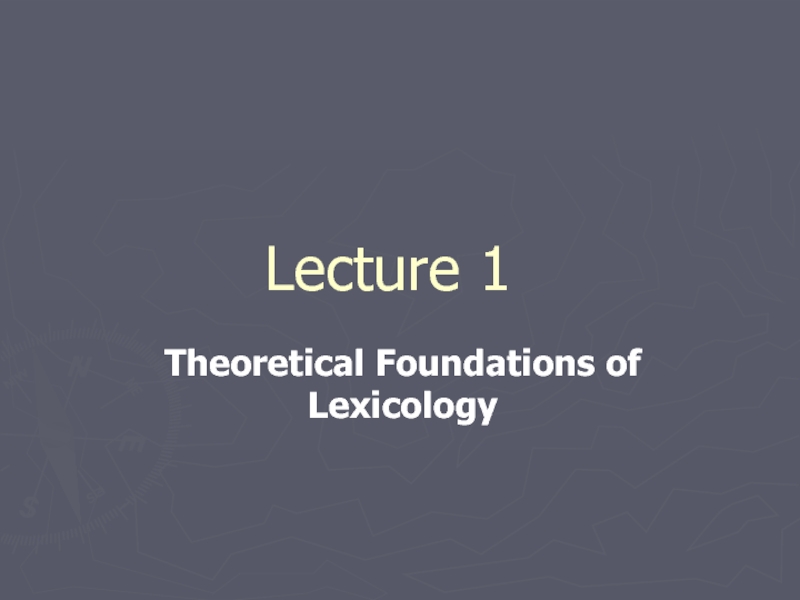
Слайд 2Is English a language of PARADOXES?
One in
every 7 human beings can speak it
More
than half of the world’s books
three-quarters of international mail are in English
The largest vocabulary
One of the noblest bodies of literature
There’s no egg in eggplant (баклажан)
There’s neither pine nor apple in pineapple (ананас)
Sweetmeats (конфеты) are candy
Sweetbreads («сладкое мясо», зобная и поджелудочная железы, употребляемые в пищу), which are not sweet, are meat, etc.
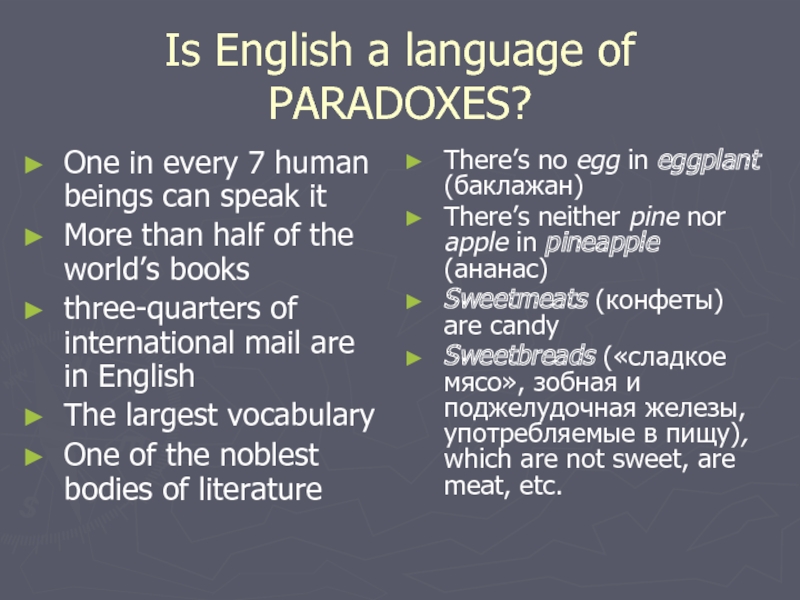
Слайд 3Plan
I. The aim and object of Lexicology.
Its branches, links with other linguistic disciplines.
II.
Definition of the word. Motivation of words. Functions of words.
III. Vocabulary as a system. Paradigmatic and syntagmatic relations. Diachronic and synchronic approaches to the study of the vocabulary.
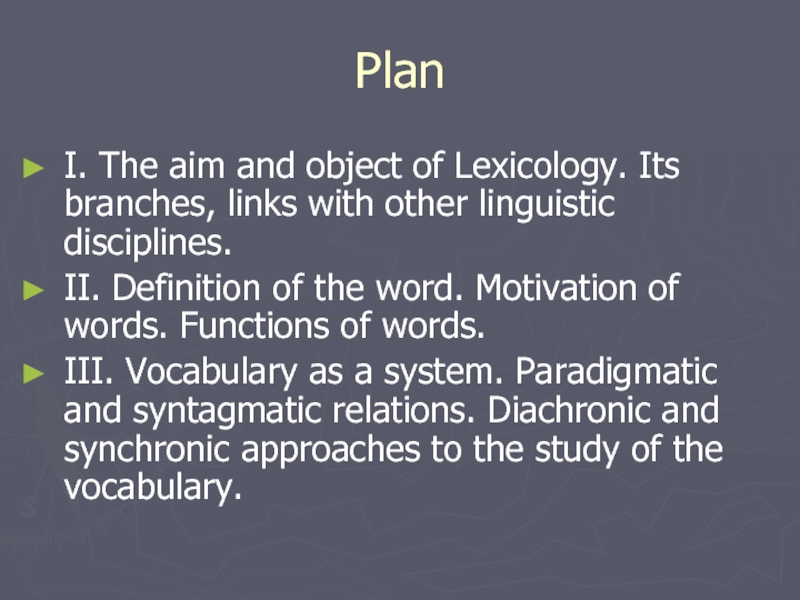
Слайд 4I. The aim and object of Lexicology.
Its branches, links with other linguistic disciplines.
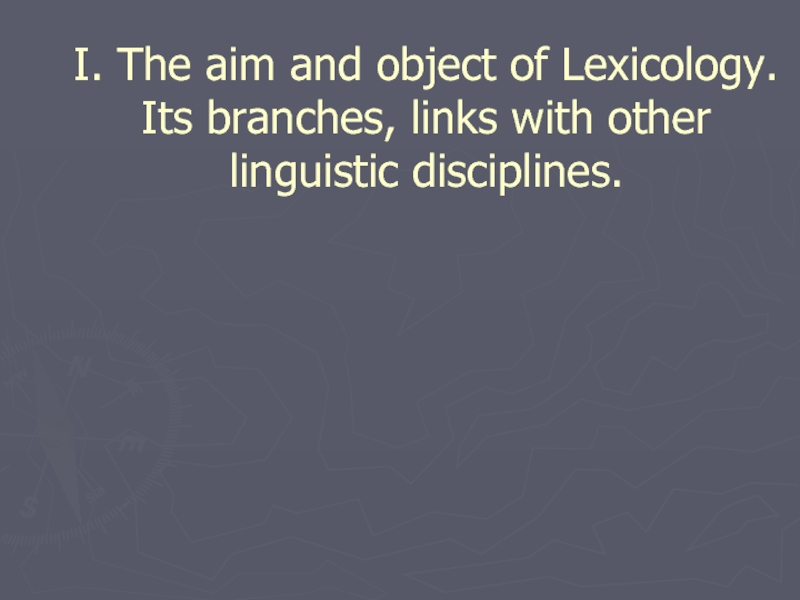
Слайд 5The aim and object of Lexicology
Lexicology (Gr.
lexis “word” and logos “learning”) is a
branch of Linguistics which studies the vocabulary of a language and characteristic features of lexical units.
Lexical units studied by Lexicology: morphemes, words, word-groups and phraseological units.
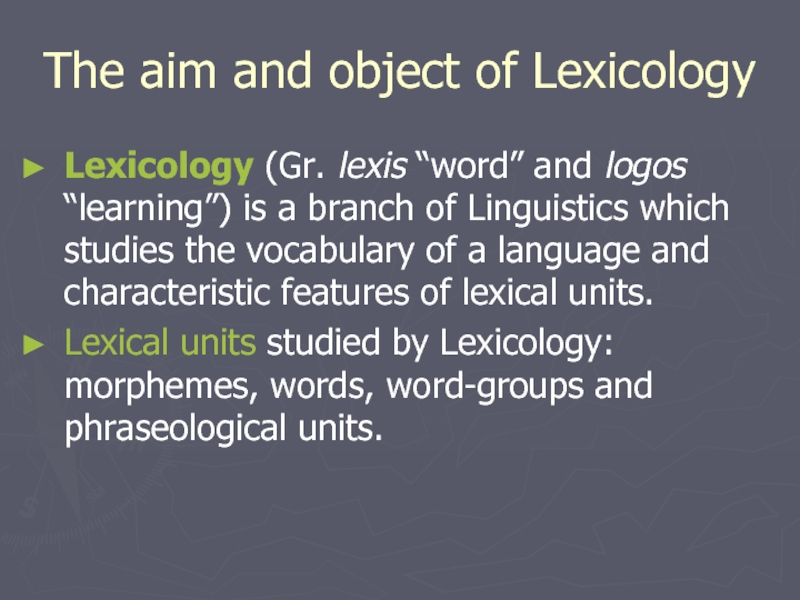
Слайд 6Branches of Lexicology
General Lexicology is general study
of words and vocabulary, irrespective of specific
features of any particular language.
Special Lexicology is Lexicology of a particular language.

Слайд 7Branches of Lexicology studying different aspects of
words (1)
Etymology studies origin of words
and historical changes in meanings: e.g. OE harvest “осень” > MnE “урожай”
Semasiology deals with semantic structure of words, development of meanings: e.g. “hand” – about 40 LSV
Word-building studies the process of creating new words, their structural and semantic patterns: e.g. drive (V+ -er)
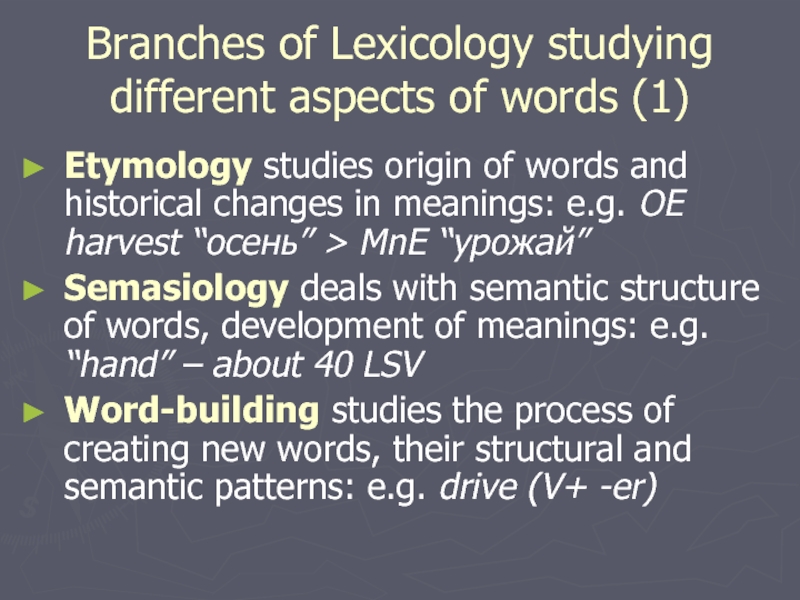
Слайд 8Branches of Lexicology studying different aspects of
words (2)
Phraseology studies word-groups with specialized meanings:
e.g. butter-fingers (растяпа)
Borrowing deals with the process of adopting and assimilating words from other languages: e.g. sky, skin – Sc.; government, army – Fr.
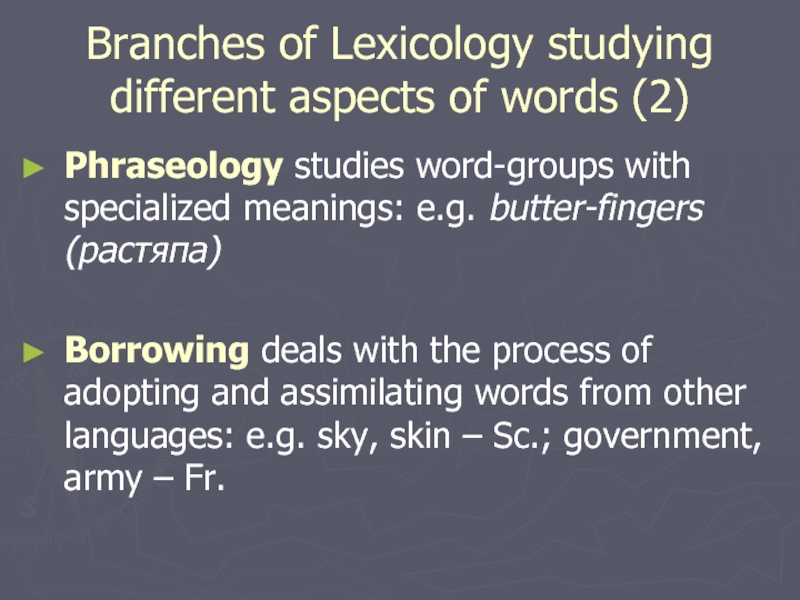
Слайд 9Links of Lexicology with other linguistic disciplines
Phonetics
Grammar
Stylistics
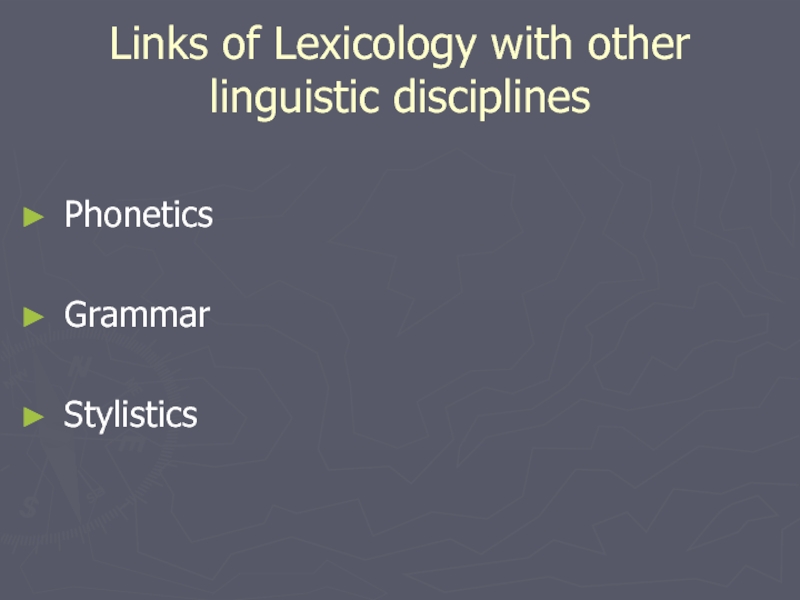
Слайд 10Connection with Phonetics
on the acoustic level words
consist of phonemes which distinguish between meanings
thus participating in signification: e.g. `object (a noun) :: ob`ject (a verb),
cop :: cope (different words), `blackbird (a compound noun) :: `black `bird (a word-group).
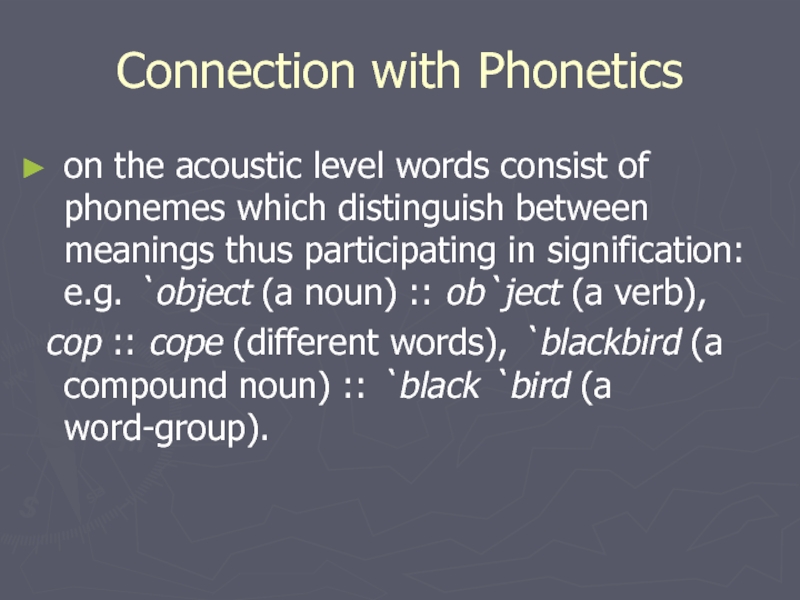
Слайд 11Connection with Grammar
The lexical meaning of a
word can be conditioned by its grammatical
forms: e.g. glass (стекло), a glass (стакан), glasses (очки);
The lexical meaning of a word may affect its grammatical forms and syntactical functions: e.g.come true, turn red, go wrong;
Grammatical meaning can be expressed by lexical means: e.g. We are going there tomorrow instead of We shall go there.
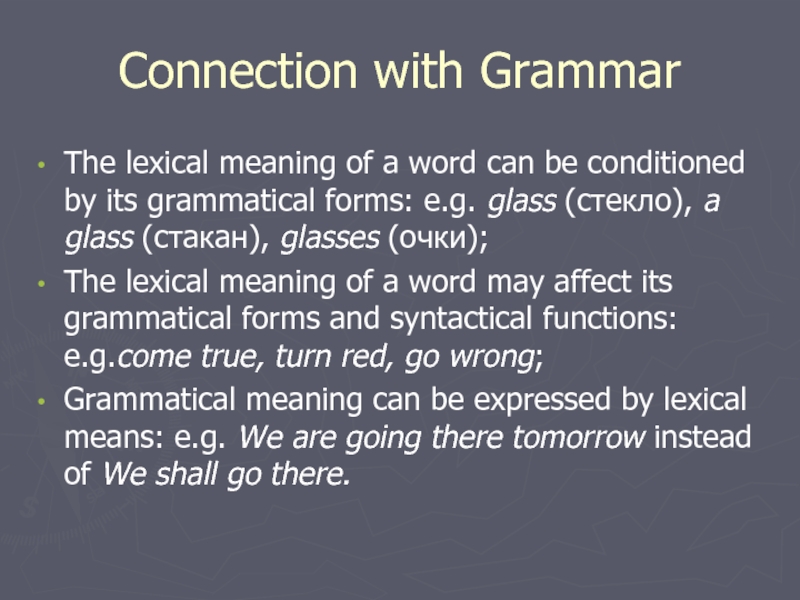
Слайд 12Connection with Stylistics
Differentiation of vocabulary according to
the functional styles of the language conditions
the connection of Lexicology with Stylistics: e.g. the synonyms father and dad differing in a shade of meaning belong to different functional styles (dad is informal, father is neutral or formal).
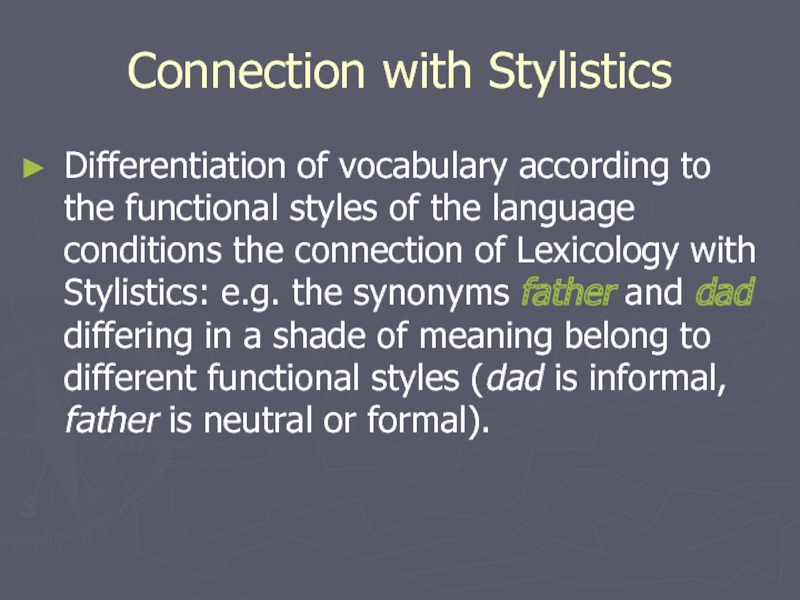
Слайд 13II. Definition of the word. Motivation of
words. Functions of words.
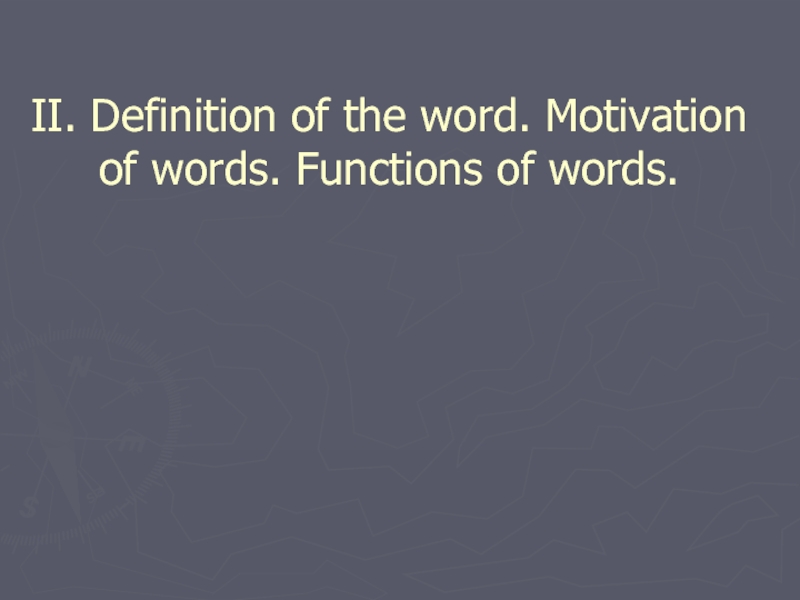
Слайд 14The Word as the Principal Object of
Lexicology
The word is the minimal (after the
morpheme) meaningful unit of the language, a two-plane linguistic sign, possessing both form (the plane of expression) and meaning (the plane of content).
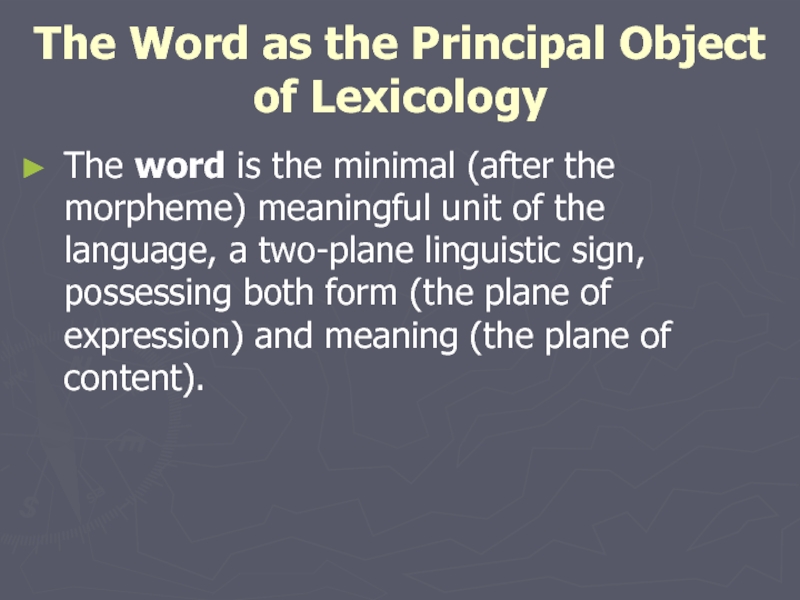
Слайд 15Asymmetrical dualism of a linguistic sign
Sound
form and meaning of a word are
firmly associated with each other in the mind of a speaker but each of them has relative independence: sound form tends to develop polysemy and further homonymy (e.g. dull – 1. lacking interest; 2. lacking brightness; 3. slow to understand, etc.), while meaning tends to develop synonymy (e.g. boring; gloomy; stupid, etc.).
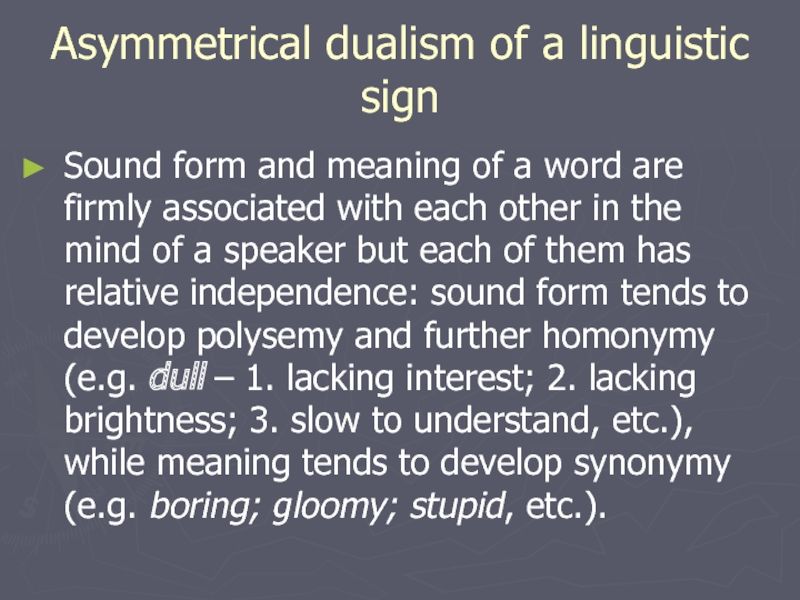
Слайд 16Motivation of words
(motivation is the relationship between
phonemic or morphemic composition of the word
and its meaning)
phonetical (e.g. hiss, buzz, cuckoo)
morphological (e.g. thinker, self-propelling, endless)
semantic (e.g. hand of a clock, mouth of a river)
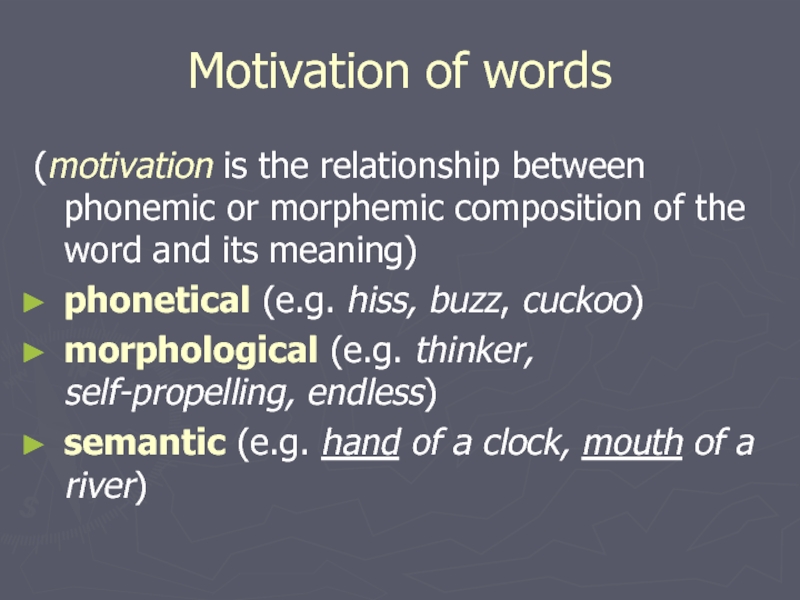
Слайд 17Phonetical motivation
1) based on similarity between the
sounds which make up words and the
sounds these words denote: e.g. boom, splash, whistle
2) based on association between some sound-clusters and a certain meaning (phonetical symbolism): e.g. [fl] (“quick movement”) – flap, flash, flutter; [sl] (“mud”) – sleet, slush
But: flat, floor, slim (non-motivated)

Слайд 18Morphological motivation
based on direct connection between the
morphological structure of the word and its
meaning: e.g. poetess, overestimate, regain, blackberry
But: repeat, matter, cranberry (non-motivated)
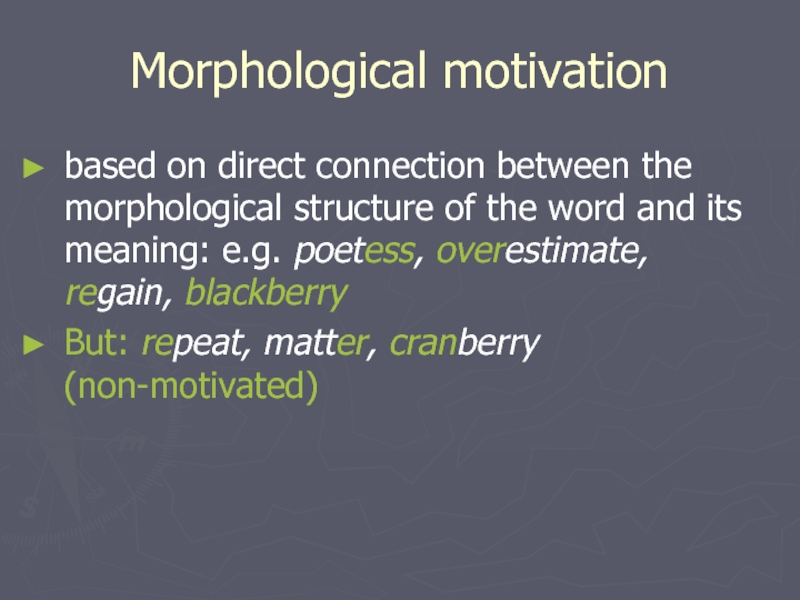
Слайд 19Semantic motivation
Based on co-existence of direct and
figurative meaning: e.g. foot of a page,
eye of a needle, head of an army (metaphoric transfer); astrakhan, china, tweed (metonymic transfer)
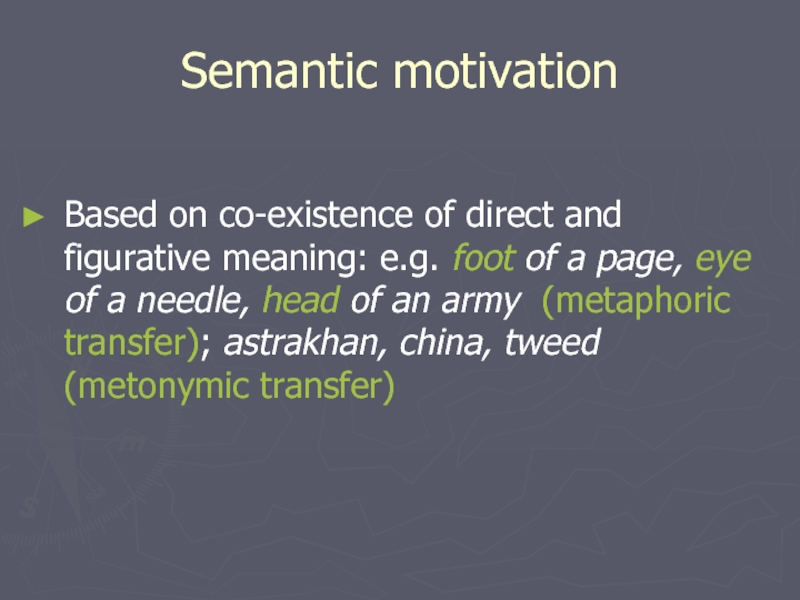
Слайд 20Functions of words (1-3)
significative function which consists
in expressing a general idea (characteristic of
all signs);
nominative function (typical of notional words);
representative function (peculiar to proper names);
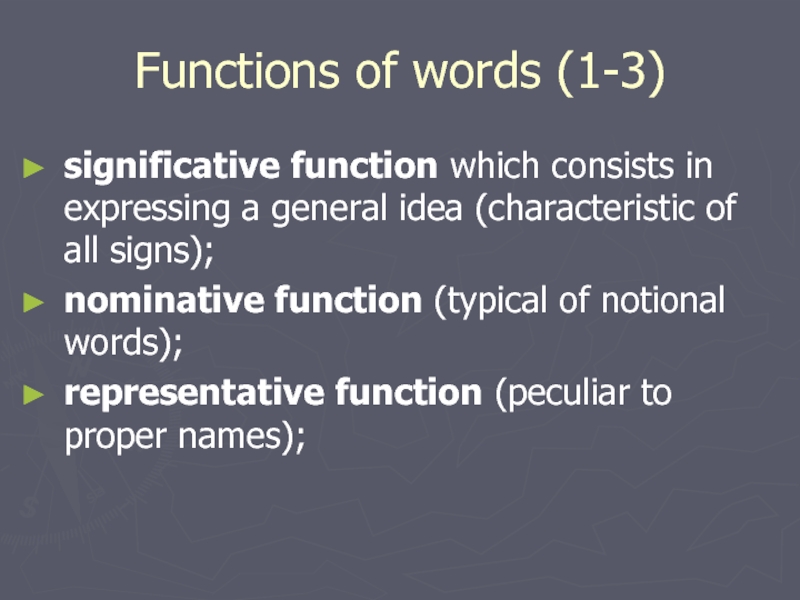
Слайд 21Functions of words (4-6)
deictic function (typical of
demonstrative, possessive, reflexive and relative pronouns and
of adverbs);
expressive function which consists in rendering emotions or attitude (peculiar to interjections oh, wow, ouch, Why! etc. and other emotionally coloured words, such as kid, dear, honey, puppy, etc.);
interpretative function (characteristic of linguistic units with transferred meaning);
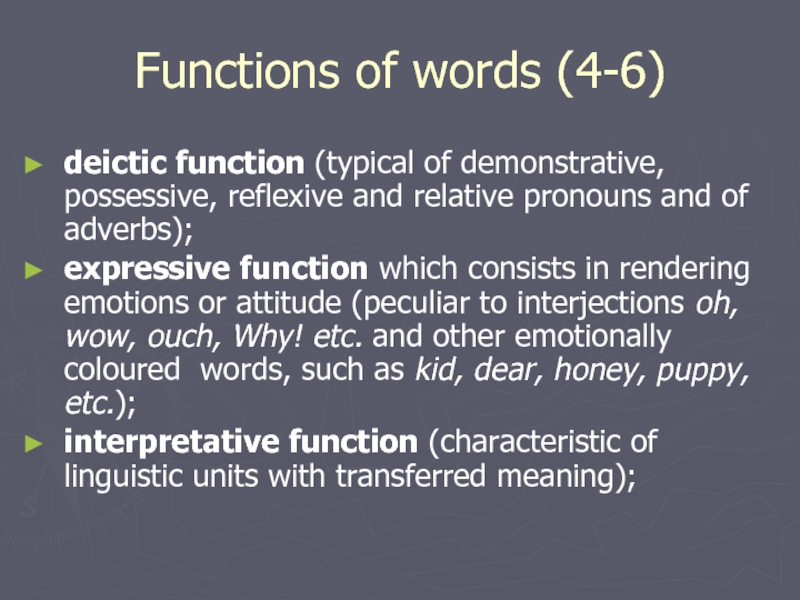
Слайд 22Functions of words (7-9)
cumulative function which consists
in enriching semantic structure of words;
pragmatic function
which consists in acquiring connotations according to the sphere of communication;
structural function which consists in serving as a basic structural material of a language
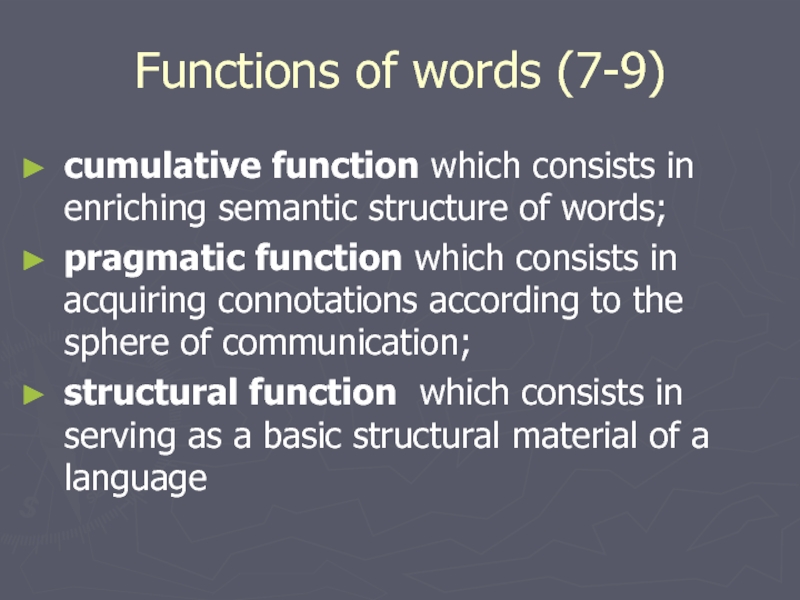
Слайд 23Word and Lexeme
The invariant of a word
in all its meanings and forms is
called lexeme.
The child wanted to play with other children (8 words, 7 lexemes)
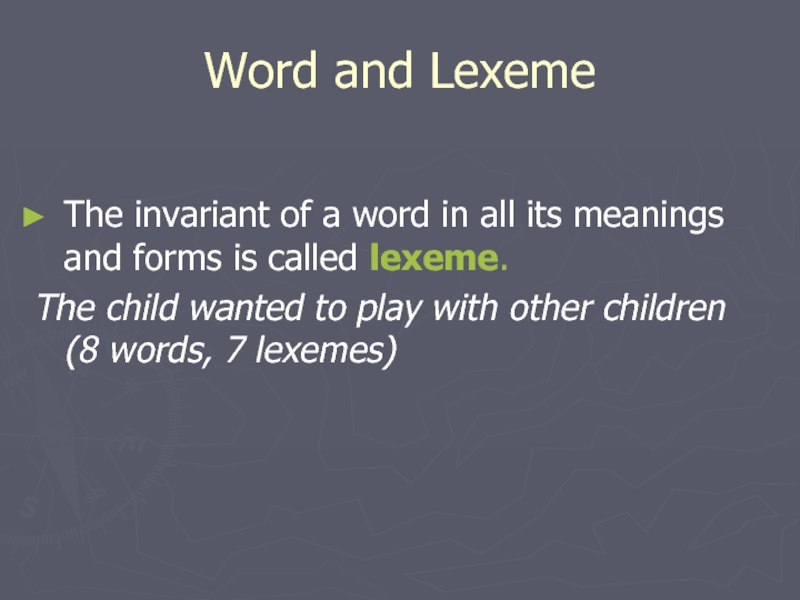
Слайд 24Word and Lexeme
The word is a unit
of speech.
The lexeme is a unit
of the lexical system of the language.
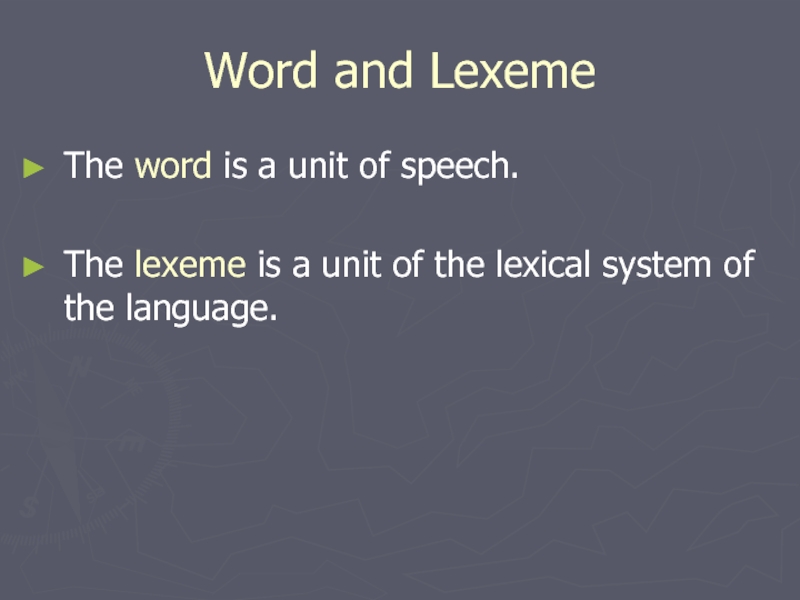
Слайд 25Word and Lexeme
The system showing a word
in all its word-forms is called a
paradigm. The lexical meaning of a word is the same through its paradigm, while the grammatical meaning is different: e.g. take – took – takes – taking.
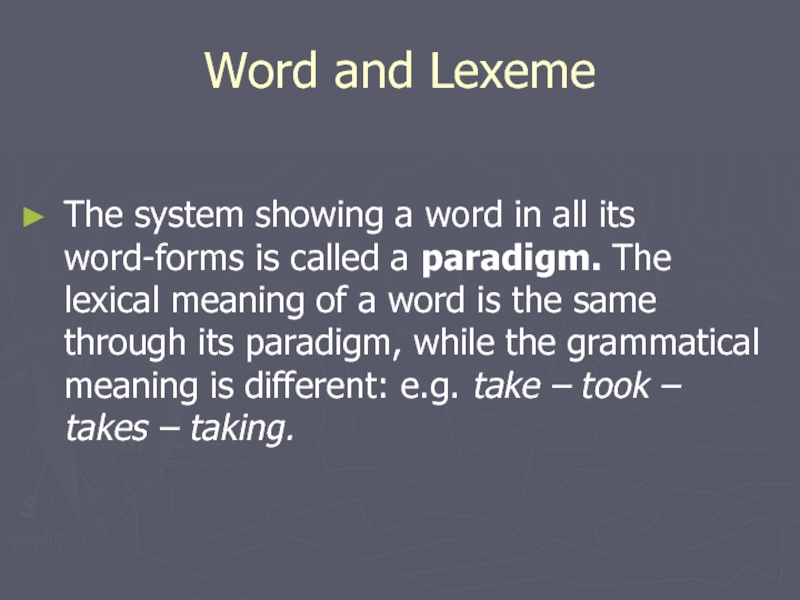
Слайд 26III. Vocabulary as a system. Paradigmatic and
syntagmatic relations. Diachronic and synchronic approaches to
the study of the vocabulary.
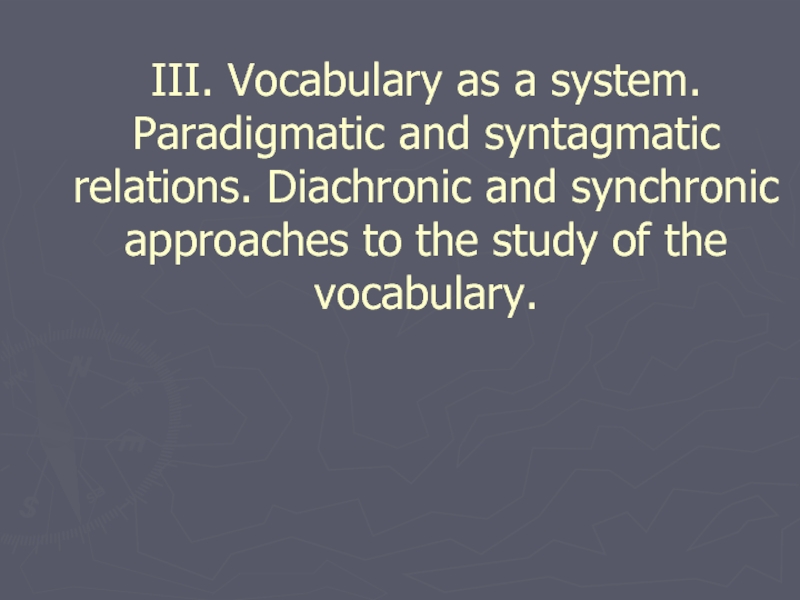
Слайд 27Vocabulary as a system
Vocabulary is a system,
i.e. a coherent homogeneous whole, constituted by
interdependent elements of the same order related in certain specific ways.
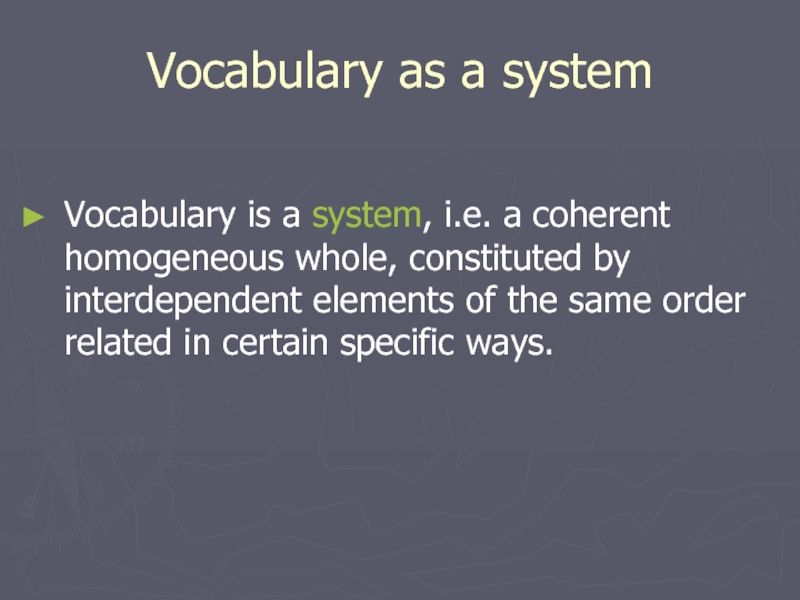
Слайд 28Relations between linguistic units
Paradigmatic relations (in
language) are based on interdependence of words
in the vocabulary system: e.g. to run, to jog, to rush, to race (synonymic group); to accept – to reject (antonyms).
Syntagmatic relations (in speech) are linear relations based on the influence of context: e.g. illegal / irregular, to tell smb. / to say smth.
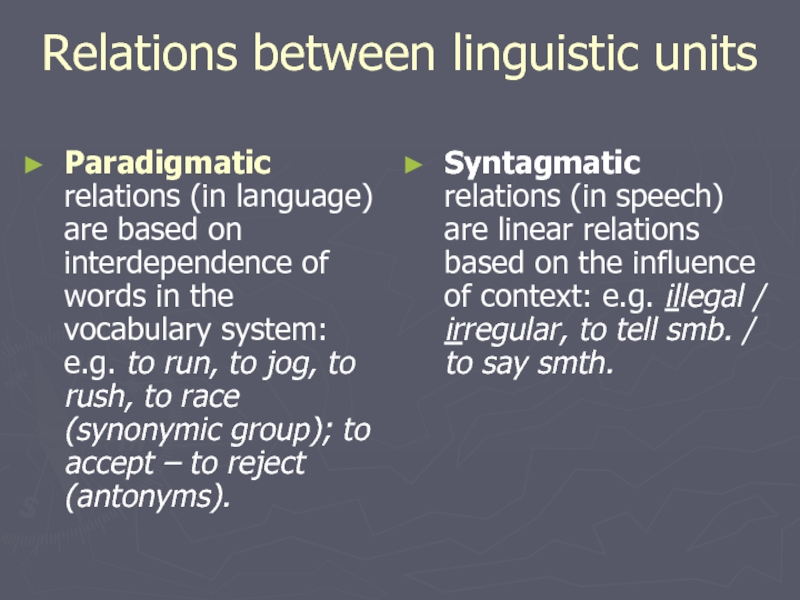
Слайд 29Approaches to the study of language material
The synchronic (Gr. syn “together, with” and
chronos “time”), or descriptive, approach deals with the vocabulary of a language as it exists at a given time
The diachronic (Gr. dia “through”), or historical, approach is concerned with the development of vocabulary in the course of time
